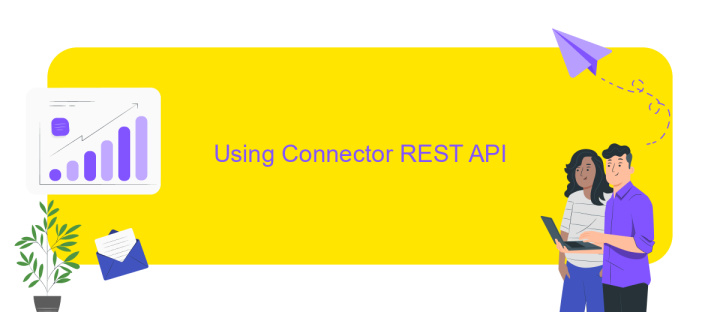Connector REST API
The Connector REST API is a powerful tool designed to streamline integration and communication between diverse software systems. By providing a standardized set of operations, it enables developers to efficiently manage data exchange and automate workflows. This API is essential for businesses looking to enhance interoperability, reduce manual efforts, and improve overall system efficiency. In this article, we will explore its key features, benefits, and implementation strategies.
Introduction
The Connector REST API is a powerful tool designed to facilitate seamless integration between diverse software systems. By providing a standardized interface, it enables developers to efficiently manage data exchange and communication across platforms, enhancing interoperability and reducing development time. This API is particularly valuable for businesses seeking to streamline operations and improve scalability by connecting disparate systems into a cohesive digital ecosystem.
- Enables easy integration with various software applications.
- Supports a wide range of data formats for flexible data handling.
- Enhances security with robust authentication and authorization mechanisms.
- Offers comprehensive documentation and support for developers.
- Facilitates real-time data exchange for improved business responsiveness.
Implementing the Connector REST API can significantly enhance the efficiency of business processes by enabling real-time data synchronization and reducing manual data entry. Its flexibility and comprehensive support make it an ideal choice for organizations aiming to leverage modern digital solutions. By adopting this API, companies can improve their operational agility, adapt to changing market demands, and maintain a competitive edge in today's fast-paced technological landscape.
Overview of Connector REST API

The Connector REST API serves as a robust framework for enabling seamless communication between diverse software applications. By providing a standardized set of operations, it facilitates the integration of various systems, allowing them to interact and exchange data efficiently. This API is particularly beneficial for businesses looking to streamline operations and enhance productivity by automating workflows and reducing the need for manual data entry. With its scalable architecture, the Connector REST API can accommodate the evolving needs of organizations, ensuring that integrations remain flexible and adaptable.
For those seeking to simplify the integration process, services like ApiX-Drive offer valuable solutions. ApiX-Drive provides a user-friendly platform that allows users to connect different applications without requiring extensive technical knowledge. By leveraging such services, businesses can quickly set up and manage integrations, ensuring that data flows smoothly between systems. This not only saves time but also reduces the risk of errors, making it an ideal choice for organizations aiming to enhance their operational efficiency. Overall, the Connector REST API, combined with integration services like ApiX-Drive, empowers businesses to achieve seamless connectivity and improved data management.
Using Connector REST API

The Connector REST API provides a robust framework for integrating various applications by allowing seamless communication between them. This API is designed to facilitate data exchange, ensuring that different systems can work together efficiently. By leveraging the Connector REST API, developers can enhance the functionality of their applications, enabling them to interact with external services and databases effortlessly.
- Authenticate your application by acquiring an API key or token from the service provider. This step is crucial to ensure secure access to the API.
- Refer to the API documentation to understand the available endpoints and supported HTTP methods. This will help you determine how to structure your requests.
- Construct your API requests using the appropriate HTTP method (GET, POST, PUT, DELETE) and include necessary headers and parameters to retrieve or manipulate data.
- Handle the API responses by parsing the returned data, which is typically in JSON format, and integrate it into your application as needed.
- Implement error handling to manage potential issues such as network errors or invalid requests, ensuring a smooth user experience.
Utilizing the Connector REST API can significantly enhance your application's capabilities by enabling it to interact with a wide range of services. With proper implementation, you can create a more dynamic and responsive user experience, ultimately improving the overall functionality of your system.
Reference

The Connector REST API serves as a pivotal tool for developers seeking seamless integration between disparate systems. It provides a standardized interface for accessing and manipulating data, ensuring that applications can communicate effortlessly. With its robust architecture, the API supports a wide range of operations, from basic CRUD (Create, Read, Update, Delete) functions to more complex transactional processes.
One of the standout features of the Connector REST API is its flexibility. Designed to accommodate various data formats such as JSON and XML, it ensures that developers can work with the format that best suits their application's needs. Additionally, its support for authentication mechanisms like OAuth 2.0 guarantees secure data exchanges.
- Comprehensive documentation for ease of use.
- Support for both synchronous and asynchronous operations.
- Built-in error handling and reporting features.
- High scalability to handle increasing loads.
By leveraging the Connector REST API, businesses can significantly reduce integration time and costs. It empowers developers to build scalable, efficient, and secure applications, fostering innovation and enhancing productivity. Whether you're integrating legacy systems or developing new solutions, this API is an indispensable asset in the modern developer's toolkit.
- Automate the work of an online store or landing
- Empower through integration
- Don't spend money on programmers and integrators
- Save time by automating routine tasks
Appendix
When working with Connector REST API, it is essential to understand the standard protocols and data formats it uses. Typically, REST APIs utilize HTTP methods such as GET, POST, PUT, and DELETE to perform operations on resources. These methods allow for seamless interaction with the API, enabling users to retrieve, update, or delete data as needed. The data is usually exchanged in JSON or XML formats, which are widely supported and easy to parse. Proper authentication, often through API keys or OAuth tokens, ensures secure access to the API, protecting sensitive information from unauthorized users.
For those looking to streamline the integration process, services like ApiX-Drive offer valuable assistance. ApiX-Drive provides tools that simplify the connection between various applications and services, reducing the complexity of manual API integration. By using such platforms, users can automate workflows and data transfers without extensive programming knowledge. This not only saves time but also minimizes the risk of errors during integration. Whether you're a developer or a business user, leveraging these tools can enhance your ability to effectively utilize Connector REST API in your projects.
FAQ
What is Connector REST API and how does it work?
What are the common use cases for Connector REST API?
How can I secure my REST API?
What are the benefits of using a service like ApiX-Drive for integrating REST APIs?
How do I handle errors in Connector REST API?
Strive to take your business to the next level, achieve your goals faster and more efficiently? Apix-Drive is your reliable assistant for these tasks. An online service and application connector will help you automate key business processes and get rid of the routine. You and your employees will free up time for important core tasks. Try Apix-Drive features for free to see the effectiveness of the online connector for yourself.


